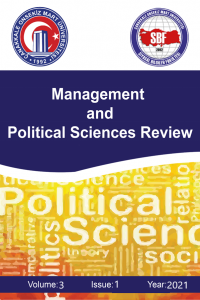Mesafenin Devlet Üniversiteleri Kayıtları Üzerindeki Etkisi: ÇOMÜ Örneği
Bu çalışma, mesafenin Türkiye’de devlet üniversiteleri kayıtları üzerindeki etkisini, öğrenci istatistikleri konusunda kapsamlı bir veri tabanı olan Çanakkale Onsekiz Mart Üniversitesi (ÇOMÜ) temelinde açıklamayı amaçlamaktadır. Çalışmamız değişkenliğin 2/3’ünü, istatistiksel olarak önemli 3 değişken kullanarak açıklayabilmektedir; i) üniversite şehrine (Çanakkale) olan mesafe, ii) diğer büyük şehirlere ve üniversitelere olan mesafe, iii) üniversite giriş sınavını geçen başarılı öğrenci sayısı. Analizler, cinsler arası tercih farklarının hala var olduğu ve mesafenin kız öğrenciler üzerindeki etkisinin erkek öğrencilere nisbeten daha düşük olduğunu göstermektedir. Ek olarak, parametrik olmayan Veri Zarflama Analizi de, beklenen sonuçlara kıyasla, muhafazakâr ve daha çok denize kıyısı olmayan Orta Anadolu’nun ÇOMÜ’yü çok daha az tercih ederken, yakın iller, Doğu Anadolu ve özellikle de Karadeniz’in ÇOMÜ’ye çok büyük ilgisinin olduğunu göstermektedir.
Anahtar Kelimeler:
Uzaklık, Üniversite Kayıtları, Etkinlik Analizi, DEA, Eğitim
Impact of Distance on State University Enrolments: The Case for ÇOMÜ
This study aims to explain the impact of distance on state university enrolments in Turkey, based on the case for Canakkale Onsekiz Mart University (ÇOMÜ), which has an extensive statistics regarding student background. We are able to explain 2/3 of the variation by using 3 highly statistically significant variables; i) distance to the college town (Çanakkale), ii) distance to the major cities and other nearby universities, iii) the number of students who pass the university entrance test. Further analysis also shows that a relatively significant gender disparity still persists, and distance is found to be much less effective on female students. Additional non-parametric data envelopment analysis also reveals that, compared to the predicted results, conservative and mostly landlocked provinces send far fewer students to ÇOMÜ while nearby provinces, Eastern Anatolia, and the Black Sea Region shows a much greater interest.
Keywords:
Distance, University Enrolments, Efficiency Analysis, DEA, Education,
___
- Akar, C. (2012). Üniversite seçimini etkileyen faktörler: iktisadi ve idari bilimler öğrencileri üzerine bir çalışma. Eskişehir Osmangazi Üniversitesi İktisadi ve İdari Bilimler Fakültesi Dergisi, 7(1), 97-120.
- Amca, H. (2011). Üniversitelerin tercihi edilmesini etkileyen faktörler. Retrieved from http://www.emu.edu.tr/amca/universitelerinTercihiEdilmesiniEtkileyenFaktorler.pdf
- Baird, L. (1967), “The educational tools of college bound youth”, American College Testing Program Research Report, Iowa.
- Banker RD, Charnes A, Cooper, (1984), WW. Some models for estimatingtechnical and scale inefficiencies in data envelopment analysis. Management Science; 30:1078–92.
- Beswick, R. L. K. (1989). A study of factors associated with student choice in the university selection process. Master thesis, University of Lethbridge.
- Bowers, T. and Pugh, R. (1972), “A comparison of factors underlying college choice by students and parents”, American Educational Research Association Annual Meeting.
- Cati, Istar, and Ozcan (2016), "Investigating the Factors that Influence the University Preference: A Countrywide Field Research in Turkey", Journal of Higher Education and Science, Volume 6, Number 2, August 2016; Pages 163-177: DOI: 10.5961/jhes.2016.153
- Chapman, D. W. (1981). A model of student college choice. Journal of Higher Education, 52(5), 490–505.
- Charnes A, Cooper WW, Rhodes E. (1978), Measuring the efficiency of decision making units. European Journal of Operational Research;2(6):429–44.
- Çokgezen, M. (2012). Determinants of University Choice: A Study on Economics Departments in Turkey. Retrieved from http://mimoza.marmara.edu.tr/~mcokgez/Makaleler/universitychoice-article-feb-2012.pdf
- ÇOMÜ Kurumsal Değerlendirme Sistemi, 2018, Retrieved from https://ubys.comu.edu.tr/BIP/BusinessIntelligence/Home/Index
- Dunnett, A., Moorhouse, J., Walsh, C. & Barry C. (2012). Choosing a university: A conjoint analysis of the impact of higher fees on students applying for university in 2012, Tertiary Education and Management, 18(3), 199-220
- Gibbons, S. & Vignoles, A. (2012). Geography, choice and participation in higher education in England. Regional Science and Urban Economics, 42, 98–113.
- Dunnett, A., Moorhouse, J., Walsh, C. & Barry C. (2012). Choosing a university: A conjoint analysis of the impact of higher fees on students applying for university in 2012, Tertiary Education and Management, 18(3), 199-220
- Filter, S. (2010). The choice-of-college decision of academically talented students, The George Washington University, Dissertation, Retrieved from http://media.proquest.com/media/pq/classic/doc/2003885961/fmt/ai/rep/NPDF?_s=gn6Nwx50WmJ6Dxi6mBmWtlq3gqo%3D.
- Hooley, G.J. and Lynch, J.E. (1981), “Modelling the student university choice process through the use of conjoint measurement techniques”, European Research, Vol. 9 No. 4, pp. 158-70.
- Kallio, R. E. (1995). Factors influencing the college choice decisions of graduate students. Research in Higher Education, 36(1), 109-124.
- Karayolları Genel Müdürlüğü, Mesafe Sorgulama, Retrieved from http://www.kgm.gov.tr/Sayfalar/KGM/SiteTr/Uzakliklar/ilcedenIlceyeMesafe.aspx
- Kurt, A. (2013). Üniversite tercih ederken nelere dikkat edilmeli? Retrieved from http://mebk12.meb.gov.tr/meb_iys_dosyalar/01/17/950146/icerikler/universite-tercih-ederkennelere-dikkat-edilmeli_355325.html.
- Moogan, J. Y., Baron S. & Harris, K. (1999). Decision-making behaviour of potential higher education students. Higher Education Quarterly, 53(3), 211–228.
- ÖSYS: Öğrenci Seçme ve Yerleştirme Sistemi, Sayısal Bilgiler, Retrieved from https://www.osym.gov.tr/TR,13046/2017.html
- Shank, M. D. & Beasley, F. (1998). Gender effects on the university selection process. Journal of Marketing for Higher Education, 8(3), 63-71.
- Soutar, G. & Turner, J. (2002). Students’ preferences for university: A conjoint analysis. The International Journal of Educational Management, 16(1), 40-45.
- Tatar E., Oktay M. (2006). Search, choice and persistence for higher education a case study in Turkey. Eurasia Journal of Mathematics, Science and Technology Education, 2(2), 115-129
- ISSN: 2636-8684
- Yayın Aralığı: Yılda 2 Sayı
- Başlangıç: 2018
- Yayıncı: Çanakkale Onsekiz Mart Üniversitesi
Sayıdaki Diğer Makaleler
ÖRGÜT İKLİMİ VE POZİTİF PSİKOLOJİK SERMAYENİN ETİK DAVRANIŞLAR ÜZERİNDEKİ ETKİSİ
Gülten GÜMÜŞTEKİN, Merve Gözde DURMAZ
ANTİ-SOSYAL DAVRANIŞLAR ÜZERİNE KAVRAMSAL BİR İNCELEME
TEDARİKÇİ SEÇİM KRİTERLERİNİN BULANIK VIKOR İLE BELİRLENMESİ
The Impact of Accounting Information Systems (AIS) on Fraud Detection
Mesafenin Devlet Üniversiteleri Kayıtları Üzerindeki Etkisi: ÇOMÜ Örneği
METODOLOJİK AÇIDAN LİSANSÜSTÜ BİTİRME TEZLERİ ÜZERİNE NİTEL BİR ARAŞTIRMA
